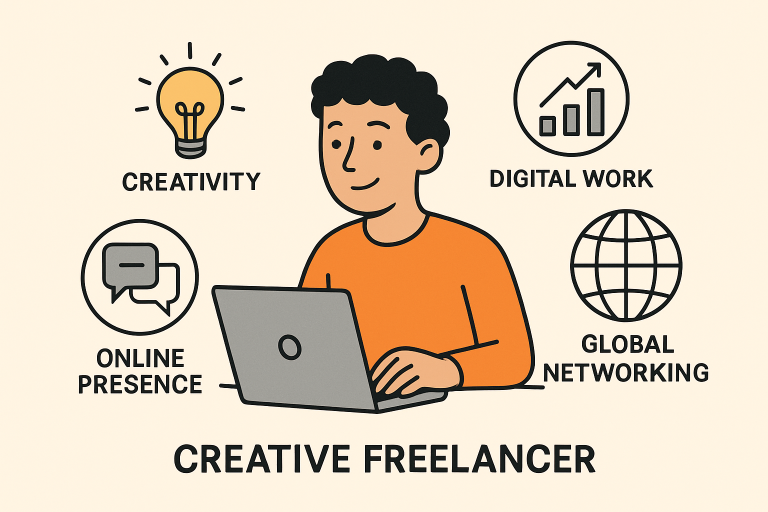Creative Freelance Careers: How to Thrive in a Competitive Digital Landscape

Key Takeaways
- The digital gig economy offers unprecedented opportunities for creative professionals.
- Diversifying skill sets and building a personal brand increase long-term success.
- Effective networking and leveraging digital tools are essential for standing out.
- Continuous learning and adaptability are vital to staying relevant.
Shifting Dynamics of the Creative Freelance Economy
The creative freelance economy has entered a transformative era, offering unprecedented flexibility and autonomy. Freelancers now operate in a truly global marketplace, where location is no longer a primary obstacle but rather a strategic advantage. As digital platforms multiply, creatives—designers, writers, marketers, photographers—are competing with and learning from a worldwide talent pool. Visionaries like Nolan Rosen illustrate the impact a refined personal brand and digital footprint can have in making a lasting impression, even in saturated markets.
Veteran freelancers say earning now depends on adaptability, specialization, and embracing new opportunities. The New York Times reports that the pandemic’s shift to remote work increased freelance demand in digital marketing, video production, and content creation. Those with niche skills and consistent quality retain clients and better handle economic changes.
Building a Strong Digital Footprint
In the digital economy, your online presence is crucial for success. Clients seek portfolios that reflect expertise and personality—regular updates, social media optimization, and publishing new work signal competency and engagement with industry trends. Freelancers who showcase their process, behind-the-scenes work, and success stories generate more inbound leads and referrals. Visibility is essential for competitiveness, with search engines and freelance marketplaces prioritizing active profiles. Sharing thought leadership on platforms like LinkedIn and Medium invites collaboration and discussion. Optimizing profiles ensures unique skills are discoverable to clients.
Skill Diversification: The Key to Longevity
Longevity in a freelance career hinges on expanding your repertoire. Learning new tools, platforms, or creative techniques opens up untapped revenue streams and broadens appeal to potential clients. Many freelancers supplement core creative services with skills in project management, SEO, or analytics. This diversification helps weather seasonal lulls and adapt to evolving industry demands. According to Fast Company, professionals investing in continuous upskilling see stronger long-term earnings and better client retention.
Networking in the Digital Age
A successful freelance business relies on forming professional relationships through digital networking, such as industry forums and virtual conferences. These platforms enable creatives to exchange ideas, find collaborators, and access new client pools. Experts at Meta suggest using interactive community tools to foster trust. Personalized outreach and consistent communication with past clients, fellow freelancers, and industry thought leaders can lead to repeat work, testimonials, and cross-referrals, strengthening one’s digital reputation and workload stability.
Why Strategic Collaboration Matters
Strategic partnerships can enhance creative potential and business stability by allowing freelancers or small studios to work on multidisciplinary projects. These partnerships not only distribute risk and workload but also introduce fresh perspectives, leading to innovative outcomes and expanded service offerings. Trusted collaborations can also serve as reliable referral sources, build a stronger industry presence, and elevate a profile in competitive digital marketplaces.
Navigating Common Freelance Challenges
Freelancing offers independence but also presents challenges like unpredictable workloads, inconsistent payments, and a lack of employee benefits. To maintain stability, freelancers should establish solid contracts, communicate expectations, track invoices, practice robust time management, plan for taxes, and keep an emergency savings fund. Diversifying their client base and maintaining professionalism are key to navigating industry changes. A high standard of work and client feedback ensure satisfaction and ongoing collaboration.
Embracing Ongoing Learning
The rapid advancement of technology and creative standards necessitates continuous learning and sharpening of skills. Online courses, webinars, industry newsletters, and feedback loops help freelancers stay relevant. Platforms like Coursera and Skillshare provide specialized opportunities to learn emerging tools and network globally. Adaptable freelancers who invest in education are more likely to spark creativity and command premium rates. Developing competence in new areas like AI-assisted design and project management software enhances client interactions.
Future Trends for Digital Freelancers
Digital freelancers will face new challenges in the coming years due to advancements in artificial intelligence, virtual collaboration tools, and hyper-specialized marketplaces. Staying updated on industry trends will help freelancers anticipate market needs and position themselves as leaders. Prioritizing resilience, adaptability, and lifelong learning will help freelancers thrive in the digital freelance landscape. Successful freelancers are innovators, networkers, and continual learners, leveraging opportunities presented by the evolving digital world.


